The Washington Quarter Test versus The Lincoln Penny Test. For many years, the Lincoln penny was the tried and true test to know when to replace a worn tire.
That approach has been updated by the “new” Washington quarter test and accepted by many in the tire industry.
Originally, it was mandated that a tire be replaced when it was worn down to 2/32”, a DOT (Department of Transportation) standard for minimum legal tread depth. For those that understand a tire’s construction, this would put the tread depth equal to the “wear bars” in the tread. That unsafe tire’s got to go!
Basically 2/32” of tread depth could be found in a simple test using the Lincoln penny (it’s 2/32” from a penny’s edge to the top of Abe’s head). If could see the top of Lincoln’s head when you inverted a penny (Lincoln’s head upside down), and stuck it down into the tread, then the tire was completely worn out, unsafe and should be replaced.
NOW ~ THE NEW AND IMPROVED TEST ~ Take a quarter instead of a penny. If it is inserted into the lowest worn slot or groove on the tire face and you can see the top of Washington’s head, then the tire should be replaced. This ‘new’ distance (from the top of George’s head to the rim of the quarter) is 4/32” (1/8” vs. a new tire at 10 or more/32”!). At this tread depth, the tire has lost a significant amount of traction, especially when braking on a wet surface, as proven in several industry tests.
In an article from Auto Week, the safety implications of proper tire tread depth was demonstrated by the folks at Tire Rack, an online tire company. They did tests, with an eye-opening video, on the difference between a new tire @ 10/32 of an inch, a worn tire @ 4/32 and a completely worn-out tire @2/32. Check out the video on their website.
Here’s an excerpt from that article:
[In the tests…} The control car stopped at 195.2 feet with new tires in the rain. The next test used the same car, but the treads were worn to 4/32 of an inch, about the distance between the top of a quarter and Washington’s head. That car took an additional 95 feet to stop on the slick track.
The next test used the same car, but the treads were worn to 4/32 of an inch, about the distance between the top of a quarter and Washington’s head. That car took an additional 95 feet to stop on the slick track.
At 2/32 of an inch of tread (the older Lincoln-penny test), the car skidded to a stop at a lengthy 378.8 feet, almost 90 feet more than the Washington-[quarter] tires and 183.6 feet farther than new tires. Maybe more importantly, the last car was still traveling at 44 mph when the Washington-[quarter] test car stopped.
The only thing between you and Mother Earth, regardless of how cool, fast and high-tech your car may be, is the contact patch of 4 tires. Don’t you and your family deserve to be on safe tires? At Pride Auto Care, we understand. See us today for all your tire and automotive service needs.
filed under: Auto News, TiresTags: Tire Repair, tires, wheels
When it comes to checking tire tread, there are a number of methods that can help you know if it’s time to replace a tire.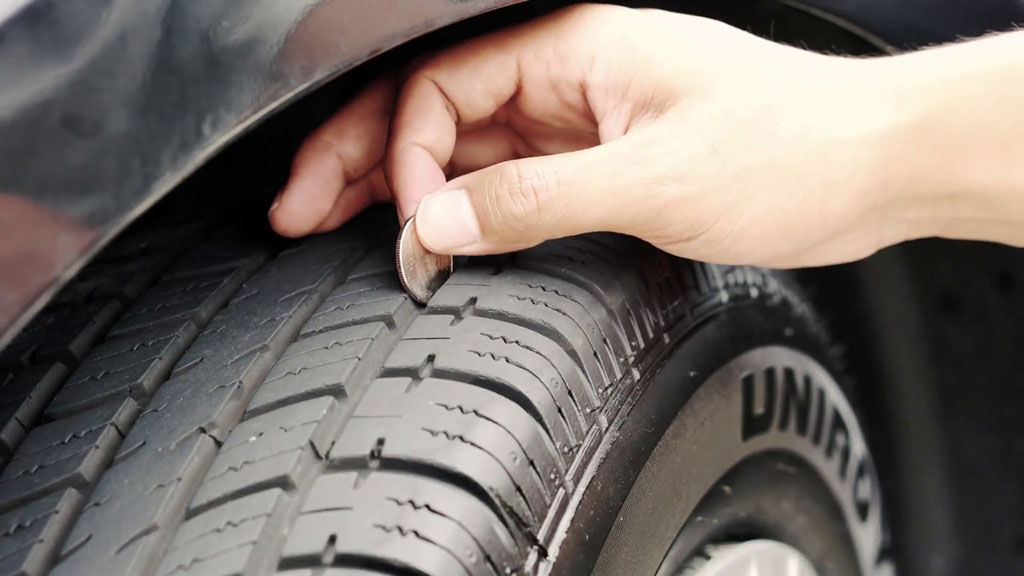 Heavily worn tread will prevent a tire from performing as designed and can lead to unsafe driving conditions. One of the simplest, most common ways to check tread depth requires nothing more than a penny and a few moments of your time.
Heavily worn tread will prevent a tire from performing as designed and can lead to unsafe driving conditions. One of the simplest, most common ways to check tread depth requires nothing more than a penny and a few moments of your time.
In the United States, tire tread depth is measured in 32nds of an inch. New tires typically come with 10/32” or 11/32” tread depths, and some truck, SUV and winter tires may have deeper tread depths than other models. The U.S. Department of Transportation recommends replacing tires when they reach 2/32”, and many states legally require tires to be replaced at this depth.
The idea of the penny test is to check whether you’ve hit the 2/32” threshold. Here’s how it works:
Place a penny between the tread ribs on your tire. A “rib” refers to the raised portion of tread that spans the circumference of your tire. Tire tread is composed of several ribs.
Turn the penny so that Lincoln’s head points down into the tread.
See if the top of his head disappears between the ribs. If it does, your tread is still above 2/32” , If you can see his entire head, it may be time to replace the tire because your tread is no longer deep enough.
When performing the penny tire test, remember not only to check each tire, but to check various places around each tire. Pay special attention to areas that look the most worn. Even if parts of your tread are deeper than 2/32”, you should still replace the tire when any areas fail the penny test.
Consistent wear around the whole tire is normal, but uneven tread wear could be a sign of improper inflation, wheel misalignment, or a variety of other things. If you see uneven tread wear, you should have a technician inspect your vehicle.
A simple way to check your tire tread depth is by using a tread depth gauge. You can find tire tread depth gauges at your local auto parts store. There are many models available, but an inexpensive simple graduated probe gauge will work just fine. All you have to do is stick the probe into a groove in the tread and press the shoulders of the probe flat against the tread block and read the result. All gauges should measure in both 32nds of an inch and millimeters.
All you have to do is stick the probe into a groove in the tread and press the shoulders of the probe flat against the tread block and read the result. All gauges should measure in both 32nds of an inch and millimeters.
Another indicator of worn out tread already lives in your tires themselves. Every performance, light truck, or medium commercial tire comes equipped with indicator bars (or wear bars) embedded between the tread ribs at 2/32”. They’re there to help you monitor tread depth and make decisions about tire replacement. Just look to see if the tread is flush with the indicator bars. If they are, it’s time to replace the tire.
While the penny tire test does deliver on what it promises – indicating whether tread has reached the legal limit – it may not be the best indicator of whether your tires are safe for the road. Tire performance can diminish significantly before your tread hits 2/32”. Even though the law deems fit for safe driving may not prevent you from hydroplaning or losing control in rainy, slushy conditions.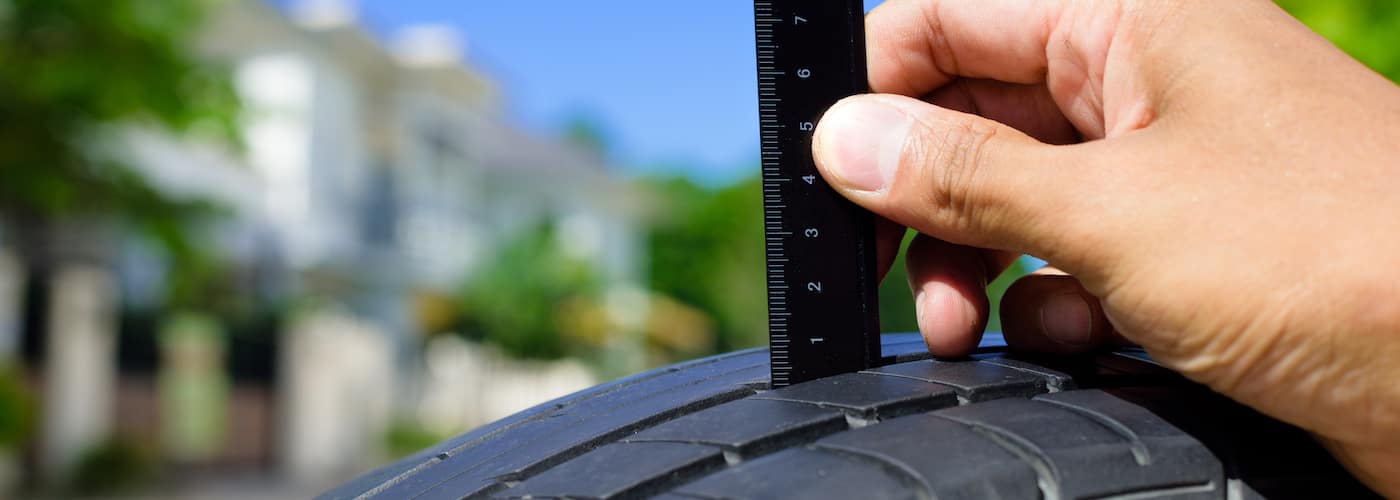 If you think your tires may be close to needing replacement, have them checked out by a licensed mechanic.
If you think your tires may be close to needing replacement, have them checked out by a licensed mechanic.
If you see abnormal wear, this is definitely a sign that you may need to balance your tires. There are basically three ways to measure tread depth: The short and stupid way, the faster and higher way, and the correct way .
As tires near the end of their life, Lincoln Penny can also be used to confirm tire tread depth. If Lincoln's entire head is visible, the tire is wearing approximately 2/32" and is considered legally worn in most states.
tire with a tread depth below 1.6 mm (2/32 inch) lacks traction. Braking distance and vehicle control are impaired. These tires are not safe to drive and should be replaced. For safety reasons, Continental recommends a minimum tread depth of 3 mm for summer tires.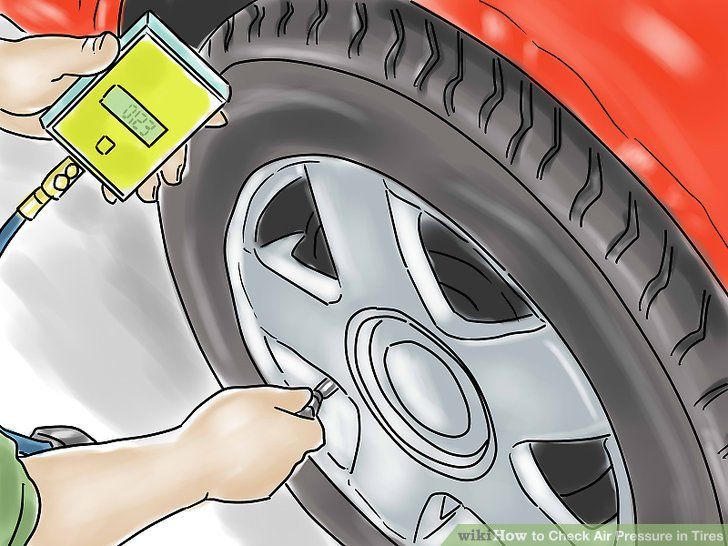
Used tires can be up to 90%, but the average is 6-8/32-1, . Tires in good condition must have a minimum of 6/32-13-13 to be useful, or 4/32 if the tire is 13-14. The average legal minimum tread depth is 2/32-, but driving becomes unsafe with this tread.
Depending on the tread compound, the tread will wear approximately 1/32 inch for every 5000 to 8500 miles of normal driving. Therefore, a new set of tires can last an average of 40,000 to 70,000 miles.
New tires have a medium tread depth 8 to 9 millimeters (10/32 to 11/32 inches). As you ride, the tread will wear out. A tire with a tread depth below 1.6 millimeters (2/32 inch) lacks traction. The braking distance and vehicle control are disturbed.
Directional/Asymmetric Tire Tread The is the best of both worlds - it has a V-shaped directional tread pattern to disperse water from the tire and dry weather asymmetrical traction for the asymmetric pass.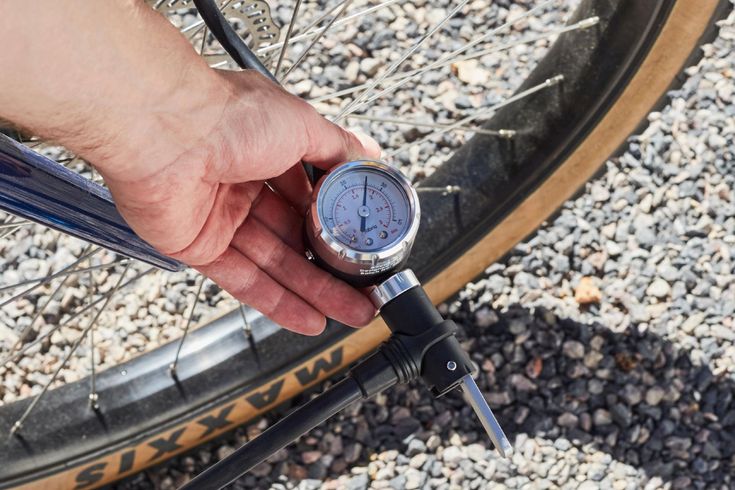
For years, motorists have been told that the "penny test" is an accurate indicator of whether you need new tires. The test is carried out by sticking the head into the tire tread; If you can see Lincoln's entire head, then you should change tires. … the one with the eighth inch of tread stopped at 300 feet.
Quarterly test
The US Department of Transportation recommends changing tires when they reach 2/32-1 and many states legally require that tires be changed at this depth.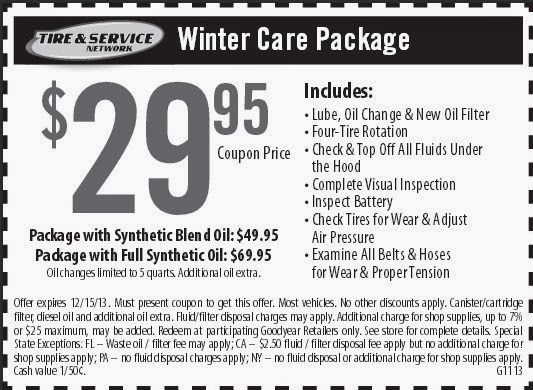 The idea of the Penny test is to check if you have reached the threshold of 2/32.
The idea of the Penny test is to check if you have reached the threshold of 2/32.
Quick Facts: When to Replace Tires
You should replace your tires when the tread depth drops below 1.6mm, which is the legal limit. Continental recommends changing summer tires at 3mm and winter tires at 4mm tread depth; Beyond this point, security and performance characteristics are not optimal.
With all possible variables taken into account, a minimum average period of 3 mm tire tread depth will last before it reaches the legal limit of 1.6 mm between 10,000-20,000 miles , but it could be significantly more than that.
New winter tire available with from 10/32" to 14/32" tread depth . Wear bars molded into voids in the tire tread indicate an absolute wear limit of 2/32 inch of tread depth.
Tread Depth What to do
6/32', your tire's tread depth is adequate for a 3 year old but approaching the minimum for a winter tire. 5 /32-, if wet roads are a concern, consider replacing your tires. 4/32 - 3/32 - seriously consider replacing your tires as soon as possible. If it is a winter tire, 4/32-€ is the minimum.
5 /32-, if wet roads are a concern, consider replacing your tires. 4/32 - 3/32 - seriously consider replacing your tires as soon as possible. If it is a winter tire, 4/32-€ is the minimum.
The direct answer is “it depends. A normal set of tires should last up to 60,000 to 75,000 miles, or four to five years. But there are a few key factors that will affect the life of your tires.
Score Protocol: A government-listed number that indicates expected tire wear. … Traction and Temperature Ratings: These ratings denote the tire's wet ability and temperature resistance. For thrust AA is best , C is worst. For thermal stability, ratings range from (best) to c.
If you drive a typical number of miles, somewhere around 12,000-15,000 miles a year, the tire's pitch will wear out in three to four years, long before the rubber complex does. But if you drive a lot less, or have a car that you only drive on the weekends, aging tires can be a problem.
But if you drive a lot less, or have a car that you only drive on the weekends, aging tires can be a problem.
Some 4WD vehicle manufacturers recommend replacing all four tires rather than just one or two because the new tire will have a larger overall diameter than the other tires. … The best approach, however, is to replace all four if the tread on older tires is significantly worn.
Quarterly tire test vs. penny tires
The penny is obviously less than a quarter, as is the distance from the edge of the coin to the top of the head. For a quarter it's about 4/32 inch but on the dime it's 2/32 th which is the minimum legal tread depth in most states.
The tire tread is the outer part of the wheel that provides traction in all weather conditions.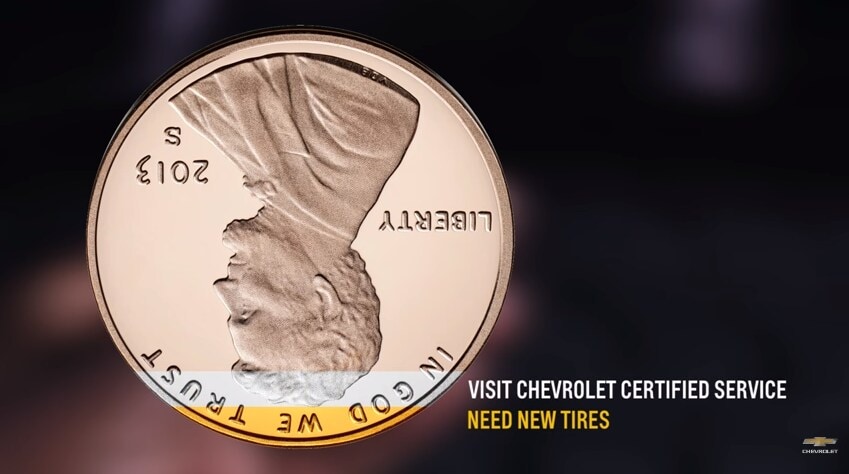 The protectors inevitably wear out during the operation of the car, the working height of the slope decreases. The residual tread depth should be periodically monitored and the set of tires should be renewed in time - this will reduce the risk of losing control of the car and save the car owner from fines from the traffic police.
The protectors inevitably wear out during the operation of the car, the working height of the slope decreases. The residual tread depth should be periodically monitored and the set of tires should be renewed in time - this will reduce the risk of losing control of the car and save the car owner from fines from the traffic police.
Tread wear rate depends on many factors:
Measuring the thickness of the tread layer will allow you to accurately determine the degree of tire wear and make a decision in time to replace them with new ones.
Different tires have different wear limits. Tread depth affects vehicle handling and road safety.
| According to Chapter 5 of the SDA, limiting norms for the height of the tread pattern have been established. For category M1 - passenger cars - as well as vehicles of categories N1, O1 and O2, the minimum allowable value is 1.6 mm. When using winter tires on snowy or icy surfaces - the limit is 4 mm. |
Let us explain what categories of vehicles we are talking about:
N1 - vehicles intended for the carriage of goods, having a technically permissible maximum mass of not more than 3.5 tons;
O1 - trailers, the technically permissible maximum mass of which is not more than 0.75 tons;
O2 - trailers, the technically permissible maximum weight of which is over 0.75 tons, but not more than 3.5 tons.
The traffic police officer has the right to measure the residual depth with a verified device. In case of a recorded violation, a fine is imposed on the car owner.
The new summer tire has an average tread depth of 7-8 mm. The service life of summer tires is usually 3-5 seasons with average mileage and moderate driving style.
| Residual height limitation by law is 1. |
Do not wait until the critical value is reached. Make sure you change tires in advance.
Winter tires are used in severe weather conditions: low temperatures, icy conditions, on snowy road surfaces. Worn elements make the tire ineffective on slippery winter roads. Accordingly, a more serious approach to the condition of the tire tread is needed.
Non-studded friction tire (Velcro) with a tread depth of 8-9mm. A new studded model - from 9 to 11 mm, some firms produce a tread with a height of 12-18 mm.
| If the tread wear is up to 4-5 mm, the winter set of tires needs to be replaced. In addition, the loss of more than 50% of the metal spikes is also a reason to change the car's shoes. |
The average life of winter tires is 2-4 years.
Universal all-weather is used in a temperate climate both in winter and in summer, it is optimal at temperatures from +10 to -10˚C. This type of tire is not suitable for use in snowfall or severe frosts. SDA allows the use of all-season tires in the winter if there is a special marking:
| All-season tires last 3-4 years on average. In summer, at high temperatures, all-weather tires wear out much faster. It is recommended to buy new tires when the tread layer is abraded to a value of 2-2.5 mm. |
You can estimate the remaining tread layer in various ways:
On some tire models there are special volumetric indicators in the form of jumpers. Check: if the tread layer is worn down to the level of the jumpers, the tire is not suitable for further use.
On the surface of certain types of tires, manufacturers knock out numbers of various depths. Depreciation is assessed visually - by the visibility of individual numbers.
Depreciation is assessed visually - by the visibility of individual numbers.
With the help of measuring instruments: from a metal ruler, caliper, depth gauge to an electronic tread depth gauge.
Many motorists measure the remaining tread depth with a coin. Warning: this method of measurement is not accurate. It will not show you actual tire wear figures.
Tire tread height should be measured at least 6 different points, preferably 9 or even 12: in the center and from both edges of the tread, at different points around the tire circumference. The measurement results at all specified points must match. If they do not match, then the tire wears unevenly. The driver should find out why this is happening. Some causes of uneven tire wear are low or high pressure in them relative to the regular one, suspension failure, extreme driving style.
Old tires have become unusable, the amount of tread remaining is approaching a critical line - no need to take risks, it's time to change your car's shoes. There is a great temptation to get by with small financial costs and purchase a set of used tires. Be careful!
There is a great temptation to get by with small financial costs and purchase a set of used tires. Be careful!
Sellers advertise used tires in good or excellent condition. Do not be too lazy to personally measure the height of the tread layer. And remember: for winter tires, a residual tread depth of 4 mm is already 100% wear.
When buying used tires with tires, it is important to remember that tires from different manufacturers and seasons initially have different tread heights (when they are new). And most importantly: the tires have, accordingly, different wear limits - the tread depth at which the tire begins to lose important characteristics. These differences are most noticeable in winter and summer tires. Keep these points in mind when measuring the remaining tread depth of used tires.
The quality of domestic roads, unfortunately, does not allow tires to be used for 7-10 years. If you still decide to buy a used kit, check the year of manufacture - it is better not to consider tires older than 8 years.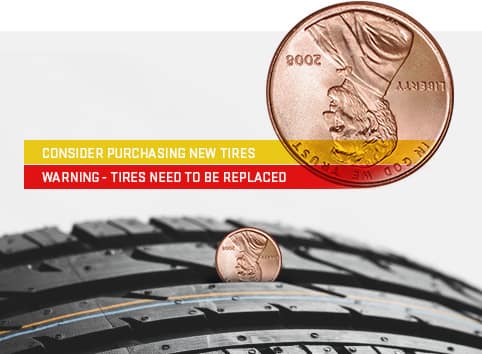
there is no guarantee for tires bought from hands;
the seller can cheat - for example, offer tires from different manufacturers in one set. Some especially enterprising salesmen even cut the tread on the worn rubber, as if the tires had not yet worn out;
you will have to spend a lot of time picking up tires from private sellers - much of what is put up for sale is only suitable for recycling;
Products may have hidden or visible defects. Visible are punctures, tears, cuts. A tire with a lot of damage can collapse in motion. Hidden defects include damage to the cord, which most often occurs after punctures or a strong blow. A car with such a malfunction may wiggle on the road, and it will be unstable;
the goods were stored in the wrong conditions, for example, under direct sunlight - this reduces the life of the tires and they will quickly become unusable, even if the residual tread depth is ideal;
it is not always possible to carry out tire fitting in the presence of the seller, you will have to check the kit yourself after payment.